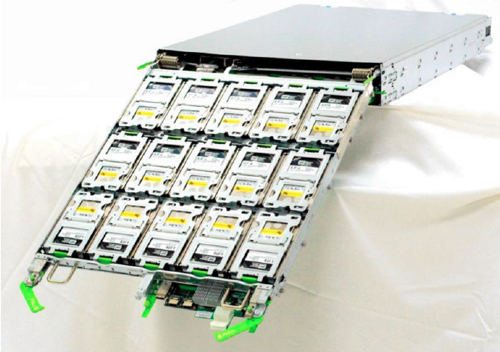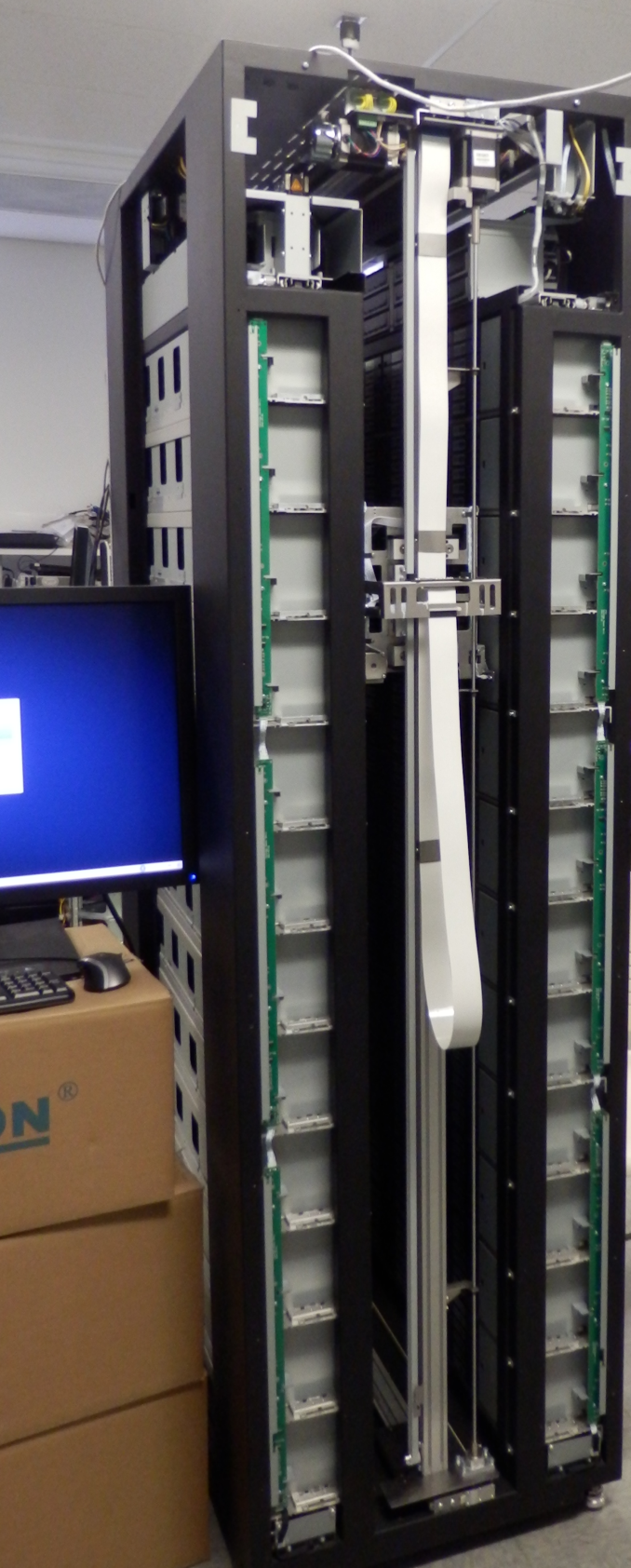The Next Generation Open Compute Hardware: Tried and Tested
by Johan De Gelas & Wannes De Smet on April 28, 2015 12:00 PM ESTMass Hot Storage: Knox
For OpenRackv1 to work, a new server design was needed that implemented bus bar connectors at the back. Using an updated Freedom-based chassis minus the PSU would cause a fair bit of empty space. Simply filling the entire space with 3.5" HDDs is wasteful, as most of Facebook's workloads aren't so storage hungry. The solution proved to be very similar to the power shelf, namely grouping the additional node storage outside the server chassis on a purpose built shelf: Knox was born.

OCP Knox with one disk sled out (Image Courtesy The Register)
Put simply, Knox is a regular JBOD disk enclosure built for OpenRack which needs to be attached to host bus adapters of surrounding Winterfell compute nodes. It differs from standard 19" enclosures for two main reasons: it can fit 30 3.5" hard disks, and it makes the job of maintenance quite easy. To replace a disk, one must simply slide out the disk sled, pop open the disk bay, swap the disk, close the bay and slide the tray back into the rack. Done.
Object Storage
Seagate has contributed the specification of a "Storage device with Ethernet interface", also known by its productized version as Seagate Kinetic. These hard disks are meant to cut out the middle man and provide an object storage stack directly on the disk, in OCP speak this would mean the Knox node would not need to be connected to a compute instance but can be directly connected to the network. Seagate, together with Rausch Netzwerktechnik, has released the 'BigFoot Storage Object Open', a new chassis designed for these hard disks, with 12x 10GbE connectivity in a 2 OU form factor.
The concept of the BigFoot system is not unknown to Facebook either, as they have released a system with a similar goal, called Honey Badger. Honey Badger is a modified Knox enclosure and pairs with a compute card -- Panther+ -- to provide (cold) object storage services for pictures and such. Panther+ is fitted with an Intel Avoton SoC (C2350 for low end up to C2750 for high end configurations), up to four enabled DDR3 SODIMM slots, and mSATA/M.2 SATA3 onboard storage interfaces. This plugs onto the Honey Badger mainboard, which in turn contains the SAS controller, SAS expander, AST1250 BMC, two miniSAS connectors and a receptacle for a 10GbE OCP mezzanine networking card. Facebook has validated two configurations for the Honey Badger SAS chipset, one based on the LSI SAS3008 chip and LSI SAS3x24R expander, the other configuration consists out of the PMC PM8074 controller joined by the PMC PM8043 expander.
Doing this eliminates the need for a 'head node', usually a Winterfell system (Leopard will not be used by Facebook to serve up Knox storage), replaced by the more efficient Avoton design on the Panther card. Another good example of modularity and lock-in free hardware design, another dollar saved.
Cold Storage
A slightly modified version of Knox is used for cold storage, with specific attention being made to running the fans slowly and only spinning a disk when required.
Facebook meanwhile has built another cold storage solution, this time using an OpenRack filled with 24 magazines of 36 cartridge-like containers, each of which holds 12 Blu-ray discs. Apply some maths and you get a maximum capacity of 10,368 discs, and knowing you can fit up to 128GB on a single BD-XL disc, you have a very dense data store of up to 1.26PB. Compared to hard disks optical media touts greater reliability, with Blu-ray discs having a life expectancy of 50 years and some discs could even be able to live on for a century.
The rack resembles a jukebox; whenever a data is requested from a certain disk, a robot arm takes the cartridge to the top, where another systems slides the right discs into one of the Blu ray readers. This system serves a simple purpose: getting as much data as possible stored in a single rack, with access latency not being hugely important.











26 Comments
View All Comments
SuperVeloce - Wednesday, April 29, 2015 - link
From Mass storage: "Compared to hard disks optical media touts greater reliability, with Blu-ray discs having a life expectancy of 50 years and some discs could even be able to live on for a century."Yeah sure. Like my expensive gold color cd's from different vendors, baked on different high quality writers, now mostly not working anymore after some 15-20 years. Despite being held in almost perfect environment all these years
Uplink10 - Wednesday, April 29, 2015 - link
Someday they are going to figure out that:-SAS HDDs are costlier but if you are using RAID it does not matter, they should use consumer drives and not overpriced enterprise drives
-I calculated sometimes back if Bluray cold storage is cheaper than HDDs but it is not and more so you cannot change the data once you write it, it is better to go with HDDs
toyotabedzrock - Wednesday, April 29, 2015 - link
You have to wonder what these networking chip vendors are hiding in the firmware that makes them so resistant to open sourcing the code.Casper42 - Monday, May 4, 2015 - link
Johan, some of the HP info at the end was interesting, but incomplete.If you (or anyone reading this) plan to talk to HP, they will also talk about their relatively new CloudLine "CL" type machines as well.
They come in standard 1RU/2RU designs as well as OpenRack designs coming soon.
And the SL line is all being morphed over to Project Apollo which uses the XL prefix.
Apollo 2500 is now live, 4X00 will replace SL4500, 6000 has already replaced S6500, and the 8000 was a net-new add for Gen9 focused on big HPC farms.
So anything SL is, or soon will be, a dead platform. (The SLs you mention could be an exception since they are not widely commercially available)
Netpower - Tuesday, June 2, 2015 - link
One general problem with this design is how to take care of power line disturbances entering the power shelves via the 277V AC lines. The 48V DC is filtered via the 48V battery but you must add a filter/power line conditioner somewhere to make sure that transients and sags doesn't kill your power shelves. The 380V DC approach by (http://www.emergealliance.org) is much more reliable and still have all the advantages with higher efficiency, lower cable losses etc.Astana - Wednesday, September 16, 2020 - link
It is believed that the nicotine addiction of a smoker prevents you from quitting. But modern research has shown that the quitting process is complicated by psychological addiction. That's why many people can't cope with the habit of smoking. But there are results with https://heroindetoxeurope.com/ drvorobjev hospital they're all successful.The problem of smoking is not only the problem of men, but also increasingly - women. Many women are wondering: "How can you quit smoking and not get better? Psychologists have proven that when a woman quits smoking, she subconsciously tries to replace, to compensate for the process of smoking with food. This feeling is also familiar to men who quit smoking, but they do not attach much importance to it. As a result, very soon an extra 3-4 kg or more will appear.